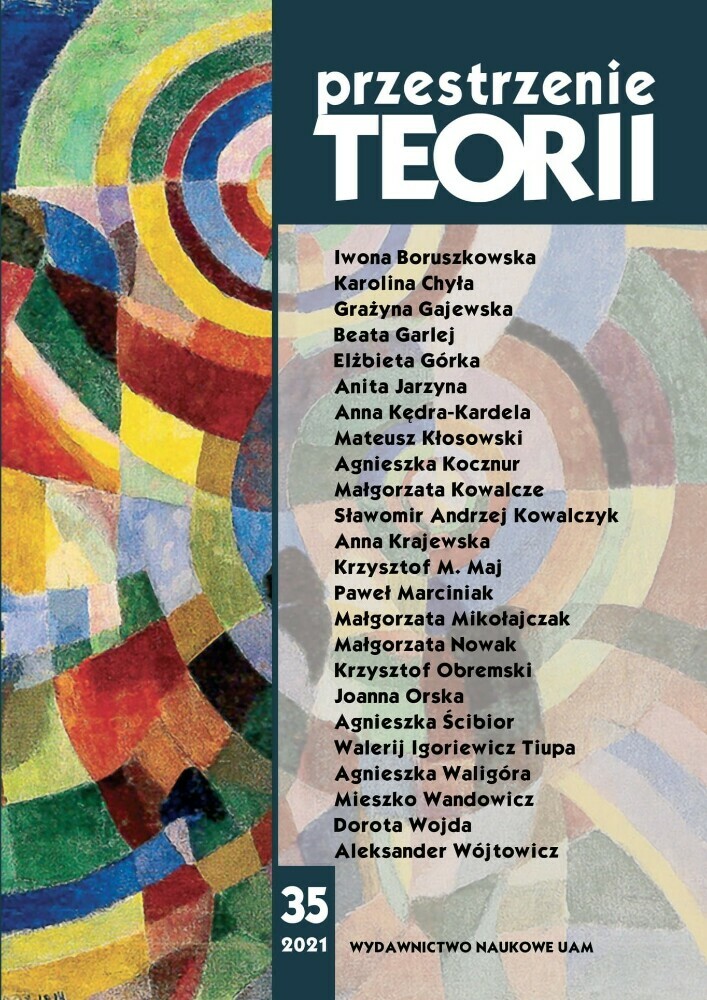Abstract
This article attempts to read Juliusz Słowacki’s Arab from the comparative perspective of John Milton’s Paradise Lost. The protagonist of Słowacki’s oriental tale, who is a variation on the Byronic hero, also shows similarities with Milton’s Satan: unceasing motion, obsession of revenge, loneliness, axiological preference of evil. The analysis of those similarities creates a new interpretative context for Arab, which was hitherto regarded as a superficial study of the pathological psyche or a caricature of the Byronic model.
References
Baillie E.M., Facing The Fiend. Satan As a Literary Character, Cambridge 2014.
Brzozowski J., Więcej niż gotycka groza. O „Arabie” Juliusza Słowackiego, [w:] Wokół gotycyzmów. Wyobraźnia, groza, okrucieństwo, red. G. Gazda, A. Izdebska, J. Płuciennik, Kraków 2002.
Byron G.G., Lara [w:] tegoż, The Poetical Works of Byron, Cambridge Edition, New York 1975.
Byron G.G., The Corsair, [w:] tegoż, The Poetical Works of Byron, Cambridge Edition, New York 1975.
Cochran P., Byron and Orientalism, Newcastle 2006.
Dobrzycka I., Kształtowanie się twórczości Byrona. Bohater bajroniczny a zagadnienie narodowe, Wrocław 1963.
Forsyth N., The Satanic Epic, Priceton 2013.
Janion M., Wampir. Biografia symboliczna, Gdańsk 2002.
Krajewska W., Polskie przekłady powieści poetyckich Byrona w okresie romantyzmu, „Pamiętnik Literacki” 1980, nr 1.
Kubacki W., Z Mickiewiczem na Krymie, Warszawa 1977.
Lasecka-Zielakowa J., Powieść poetycka w Polsce w okresie romantyzmu, Wrocław 1990.
Maciejewski J., Powieści poetyckie Słowackiego, Poznań 1991.
Milton J., Paradise lost and Paradise Regained, London 2013.
Milton J., Raj utracony, przeł. M. Słomczyński, wyd. 2, Kraków–Wrocław 1986.
Peerie W., The Byronic Philosophy, [w:] Byron. Wrath and Rhyme, red. A. Bold, London–New York 1983.
Pismo Święte Starego i Nowego Testamentu. Najnowszy przekład z języków oryginalnych z komentarzem, oprac. Zespół Biblistów Polskich z inicjatywy Towarzystwa Świętego Pawła, Częstochowa 2011.
Piwińska M., Złe wychowanie. Fragmenty romantycznej biografii, Warszawa 1981.
Praz M., Zmysły, śmierć i diabeł w literaturze romantycznej, przeł. K. Żaboklicki, wyd. 2, Gdańsk 2010.
Rawski J., Wampiryczny kochanek „orientalnej Karusi”, czyli „Arab” Juliusza Słowackiego wobec „Romantyczności” Adama Mickiewicza, [w:] Słowacki i wiek XIX. W kręgu badań postmodernistycznych, t. 2, red. M. Ruszczyńska i J. Rawski, Zielona Góra 2016.
Revard S.P., The War in Heaven. Paradise Lost and the Tradition of Satan’s Rebellion, Ithaca–London 1980.
Russell J.B., Prince of Darkness. Radical Evil and the Power of Good in History, Ithaca 1988.
Sielewońko M., Model bohatera romantycznego w wybranych utworach Juliusza Słowackiego (Arab, Balladyna, Lambro, Mazepa), „Annales Universitatis Mariae Curie-Skłodowska Lublin – Polonia, Sectio FF” 2015, vol. XXXIII.
Sinko Z., Twórczość Johna Miltona w oświeceniu polskim, Warszawa 1992.
Słowacki J., Arab, [w:] tegoż, Powieści poetyckie, oprac. M. Ursel, wyd. 4 zmienione, Wrocław–Kraków 1986.
Tretiak A., Literatura angielska okresu romantyzmu, 1798–1830, Lwów 1928.
Tretiak A., Lord Byron, Poznań 1930.
Treugutt S., Pisarska młodość Słowackiego, Wrocław 1958.
Vyverberg H., Human Nature, Cultural Diversity and the French Enlightenment, New York 1989.
Waswo R., Devilish and Divine Economics in (and after) Paradise Lost, [w:] After Satan. Essays in Honour of Neil Forsyth, red. K. Stirling, M.H. Dutheil de la Rochere, Newcastle 2010.
Wnuk A., Polska romantyczna powieść poetycka. Wyznaczniki i konteksty gatunkowe, Warszawa 2014.
Zając R., Szatan w Starym Testamencie, Lublin 1998.
Ziemba K., Wyobraźnia a biografia. Młody Słowacki i ciągi dalsze, Gdańsk 2006.
License
Authors
Authors of texts accepted for publication in Przestrzenie Teorii are required to complete, sign and return to the editor's office the Agreement for granting a royalty-free license to works with a commitment to grant a CC sub-license.
Under the agreement, the authors of texts published in Przestrzenie Teorii grant the Adam Mickiewicz University in Poznań a non-exclusive, royalty-free license and authorize the use of Attribution-NonCommercial-NoDerivatives 4.0 International (CC BY-NC-ND 4.0) Creative Commons sub-license.
The authors retain the right to continue the free disposal of the work.
Users
Interested Internet users are entitled to use works published in Przestrzenie Teorii since 2015, for non-commercial purposes only, under the following conditions:
- attribution - obligation to provide, together with the distributed work, information about the authorship, title, source (link to the original work, DOI) and the license itself.
- no derivatives - the work must be preserved in its original form, without the author's consent it is not possible to distribute the modified work, such as translations, publications, etc.
Copyrights are reserved for all texts published before 2015.
Miscellaneous
Adam Mickiewicz University in Poznań retains the right to magazines as a whole (layout, graphic form, title, cover design, logo etc.).

